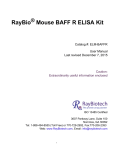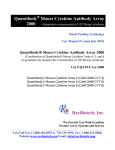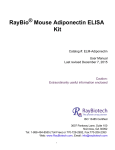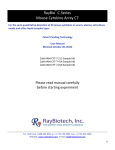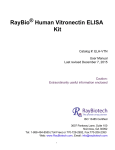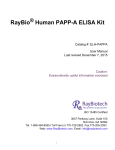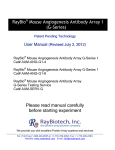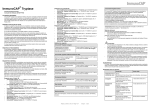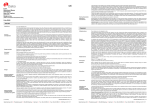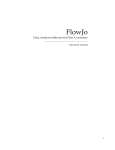Download RayBiotech, Inc. Quantibody Mouse Cytokine Antibody Array
Transcript
Quantibody Mouse Cytokine Antibody Array 4000 --Quantitative measurement of 200 mouse cytokines Patent Pending Technology User Manual (Version Dec 2013) Quantibody Mouse Cytokine Antibody Array 4000 (Combination of Quantibody Mouse Cytokine Array 4, Mouse Cytokine Array 5, Mouse Cytokine Array 6, Mouse Cytokine Array 7 and Mouse Cytokine Array 8 to quantitatively measure the concentration of 200 mouse cytokines) Cat # QAM-CAA-4000 Quantibody Mouse Cytokine Array 4 (Cat# QAM-CYT-4) Quantibody Mouse Cytokine Array 5 (Cat# QAM-CYT-5) Quantibody Mouse Cytokine Array 6 (Cat# QAM-CYT-6) Quantibody Mouse Cytokine Array 7 (Cat# QAM-CYT-7) Quantibody Mouse Cytokine Array 8 (Cat# QAM-CYT-8) RayBiotech, Inc. We Provide You With Excellent Protein Array Systems and Service Tel:(Toll Free) 1-888-494-8555 or 770-729-2992; Fax: 1-888-547-0580; Website:www.raybiotech.com Email: [email protected] Cytokine Detected 200 Quantibody® Mouse Cytokine Array 4 (40) Axl, CD27L, CD30T, CD40, CXCL16, EGF, E-selectin, Fractalkine, GITR, HGF, IGFBP-2, IGFBP-3, IGFBP-5, IGFBP-6, IGF-I, IL-12p70, IL-17E, IL-17F, IL-1ra, IL-2 Rα, IL-20, IL-23, IL-28, I-TAC, MDC, MIP-2, MIP-3α, OPN, OPG, Prolactin, Pro-MMP-9, P-selectin, Resistin, SCF, SDF-1α, TPO, VCAM-1, VEGF, VEGF-D bFGF, BLC, CD30L, Eotaxin, Eotaxin-2, Fas L, G-CSF, GM-CSF, Quantibody® Mouse ICAM-1, IFNγ, IL-1α, IL-1β, IL-2, IL-3, IL-4, IL-5, IL-6, IL-7, IL-10, Cytokine Array 5 (40) IL-12p40, IL-13, IL-15, IL-17, IL-21, KC, Leptin, LIX, MCP-1, MCP-5, M-CSF, MIG, MIP-1α, MIP-1γ, PF-4, RANTES, TARC, TCA-3, TNFα, TNFRI, TNFRII Quantibody Mouse Cytokine Array 6 (40) Quantibody Mouse Cytokine Array 7 (40) Quantibody Mouse Cytokine Array 8 (40) Format Detection Method 4-1BB, ACE, ALK-1, CT-1, CD27, CD40L, CTLA-4, Decorin, Dkk-1, Dtk, Endoglin, Fcγ RIIB, Flt-3 L, Galectin-1, Galectin-3, Gas 1, Gas 6, GITR L, HAI-1, HGF R, IL-1 R4, IL-3 Rβ, IL-9, JAM-A, Leptin R, LSelectin, Lymphotactin, MadCAM-1, MFG-E8, MIP-3β, Neprilysin, Pentraxin 3, RAGE, TACI, TREM-1, TROY, TSLP, TWEAK R, VEGF R1, VEGF R3 B7-1, BAFF R, BTC, C5a, CCL6, CD48, CD6, Chemerin, Clusterin, CXCL15, Cystatin C, DAN, DLL4, EDAR, Endocan, Fetuin A, H60, IL33, IL-7 Ralpha, Kremen-1, Limitin, Lipocalin-2, LOX-1, Marapsin, MBL-2, Meteorin, Nope, NOV, Osteoactivin, OX40, Ligand, P-Cadherin, Periostin, PlGF-2, Progranulin, Prostasin, Renin 1, Testican 3, TIM-1, TRAIL, Tryptase epsilon 6Ckine, Activin A, ADAMTS1, Adiponectin, ANG-3, ANGPTL3, Artemin, CCL28, CD36, Chordin, CRP, E-Cadherin, Epigen, Epiregulin, Fas, Galectin-7, gp130, Granzyme B, Gremlin, IFN-γ R1, IL-17B, IL17B R, IL-22, MIP-1β, MMP-2, MMP-3, MMP-10, PDGF-AA, Persephin, sFRP-3, Shh-N, SLAM, TCK-1, TECK, TGFβ1, TRANCE, TremL1, TWEAK, VEGF-B, VEGF-R2 One standard glass slide is spotted with 16 wells of identical cytokine antibody arrays. Each antibody is arrayed in quadruplicate. Fluorescence with laser scanner: Cy3 equivalent dye Sample Volume 50 – 100 µl per array Reproducibility CV <20% Assay duration 6 hrs Quantibody Mouse Cytokine Antibody Array 4000 1 TABLE OF CONTENTS I. Overview ……………………………………………………………………………………………………………….……………………………..………….…. Introduction …............................................................................................................................................................................................................................ How It Works II. ………………………………………………………………………………………………………………………………………...…... Materials Provided …………………………………………………………………………………………………………..…………..…….. Additional Materials Required III. General Considerations ……………………………………………………………………………………………...…….……… A. Preparation of Samples 6 6 7 ………………………………………………………………………………………………….…….. 7 …………………………………………………………………………………………………………………………….…………….…… 7 ………………………………………………………………………………………………………………………………………...…………………….… 8 A. Complete Air Dry the Glass Slide ………………………………………………………………… B. Prepare Cytokine Standard Dilutions C. Blocking and Incubation ……………………………………………..……….. 8 9 .....................................… E. Incubation with Cy3 Equivalent Dye-Streptavidin 10 ………….. 11 ……………………………………………………………………………………….…………… 11 ………………………………………………………………………………………………………………………...………….. 12 F. Fluorescence Detection G. Data Analysis 8 ……………………………………………………………………………………..…………. D. Incubation with Detection Antibody Cocktail Cytokine Array Map ………………………………………………………………………………………………………………..……... 13 …………………………………………………………………………………………………………………….…………... 14 …………………………………………………………………………………………….………………………………...….. 18 VI. 8-Point Standards VII. System Recovery VIII. Quantibody® Q-Analyzer IX. Troubleshooting Guide X. 5 7 C. Incubation V. 3 …………………………………………………………………………………….………….…… B. Handling Glass Slides IV. Protocol ………………………………………………………………………….……..…… 1 …….………………………………..……………………………………………………..………... 18 …………………………………………………………………………………………………………….... 19 Select Quantibody Publications …………………………………………………………………..……..……….. 20 ………………………………………………………………………………………..………. 21 XI. Experimental Record Form Quantibody Mouse Cytokine Antibody Array 4000 2 I. Introduction Cytokines play an important role in innate immunity, apoptosis, angiogenesis, cell growth and differentiation. They are involved in interactions between different cell types, cellular responses to environmental conditions, and maintenance of homeostasis. In addition, cytokines are also involved in most disease processes, including cancer and cardiac diseases. The traditional method for cytokine detection and quantification is through the use of an enzyme-linked immunosorbent array (ELISA). In this method, a target protein is first immobilized to a solid support. The immobilized protein is then complexed with an antibody that is linked to an enzyme. Detection of the enzyme-complex can then be visualized through the use of a substrate that produces a detectable signal. While this traditional method works well for a single protein, the overall procedure is time consuming and requires a relatively high volume of sample. Thus, conservation of precious small sample quantities becomes a risky task. To solve this problem take advantage of the innovations in microarray technology over the last decade. A long-standing leader in the field, Raybiotech, has pioneered the development of cytokine antibody arrays, which have now been widely applied in the research community with hundreds of peer reviewed publications including top tier journals, such as in Cell and Nature. The Quantibody® array, our quantitative array platform, uses the multiplexed sandwich ELISA-based technology and enables researchers to accurately determine the concentration of multiple cytokines simultaneously. It combines the advantages of the high detection sensitivity & specificity of ELISA and the high throughput of arrays. Like a traditional sandwich-based ELISA, it uses a pair of cytokine specific antibodies for detection. A capture antibody is first bound to the glass surface. After incubation with the sample, the target cytokine is trapped on the solid surface. A second biotin-labeled detection antibody is then added, which can recognize a different isotope of the target cytokine. The cytokine-antibody-biotin complex can then be visualized through the addition of the streptavidin-labeled Cy3 equivalent dye using a laser scanner. Unlike the traditional ELISA, Quantibody products use array format. By arraying multiple cytokine specific capture antibodies Quantibody Mouse Cytokine Antibody Array 4000 3 onto a glass support, quantitative, multiplex detection of cytokines in one experiment is made possible. In detail, one standard glass slide is divided into 16 wells of identical cytokine antibody arrays. Each antibody, together with the positive controls is arrayed in quadruplicate. The slide comes with a 16-well removable gasket which allows for the process of 16 samples on one slide. Four slides can be nested into a tray, which matches a standard microplate footprint and allows for automated robotic high throughput process of 64 arrays simultaneously. For cytokine quantification, the array specific cytokine standards, whose concentration has been predetermined, are provided to generate a standard curve for each cytokine. In a real experiment, standard cytokines and samples will be assayed in each array simultaneously through a sandwich ELISA procedure. By comparing signals from unknown samples to the standard curve, the cytokine concentration in the samples will be determined. Quantibody® array kits have been confirmed to have similar detection sensitivity as traditional ELISA. Our current high density Quantibody kits allow scientists to quantitatively determine the concentration of 400 human 200 mouse, or 100 rat cytokines in a single experiment. This is not only one of the most efficient products on the market for cytokine quantification, but makes it more affordable for quantification of large number of proteins. Simultaneous detection of multiple cytokines undoubtedly provides a powerful tool for drug and biomarker discovery. Quantibody Mouse Cytokine Antibody Array 4000 4 How It Works Array support Samples Incubation of Sample With arrayed antibody Supports 1-2 hr Cocktail of Biotin-Ab Incubation with Biotinylated Ab Labeled – streptavidin Incubation with Cy3 equivalent dye Labeled- streptavidin Detection of signals Data analysis and graph Quantibody Mouse Cytokine Antibody Array 4000 5 1-2 hr 1 hr II. Materials Provided Upon receipt, all components of the Quantibody Array kit should be stored at -200C. At -200C the kit will retain complete activity for up to 6 months. Once thawed, the glass slide, cytokine standard mix, detection antibody cocktail and Cy3 equivalent dye-conjugated Streptavidin should be kept at – 200C and all other components may be stored at 40C. The entire kit should be used within 6 months of purchase. Components Item 1 2 3 4 5 6 7 8 9 10 Description Quantibody Array Glass Slide Sample Diluent 20X Wash Buffer I 20X Wash Buffer II Lyophilized cytokine standard mix Detection antibody cocktail Cy3 equivalent dye-conjugated Streptavidin Slide Washer/Dryer Adhesive device sealer Manual QAM-CCA-4000-1 5 5 10 5 5 5 5 QAM-CCA-4000-2 10 5 15 5 10 10 10 5 25 5 5 50 5 * The independent sets of reagents for Quantibody Mouse Cytokine Array 4, 5, 6, 7, and 8 were shipped in three different boxes. Among all the reagents, the glass slide, lyophilized cytokine standard mix, and detection antibody cocktail are array specific, while all other reagents are interchangeable between the arrays. Note: See Section VI for detailed cytokine concentrations after reconstitution. Additional Materials Required • Orbital shaker • Laser scanner for fluorescence detection • Aluminum foil • ddH2O • 1.5ml Polypropylene microcentrifuge tubes Quantibody Mouse Cytokine Antibody Array 4000 6 III. General Considerations A. Preparation of Samples • Use serum-free conditioned media if possible. • If serum-containing conditioned media is required, it is highly recommended that complete medium be used as a control since many types of sera contains cytokines. • We recommend the following parameters for your samples: 50 to 100 µl of original or diluted serum, plasma, cell culture media, or other body fluid, or 50-500 µg/ml of protein for cell and tissue lysates. If you experience high background or the readings exceed the detection range, further dilution of your sample is recommended. B. Handling glass slides • Do not touch the surface of the slides, as the microarray slides are very sensitive. Hold the slides by the edges only. • Handle all buffers and slides with latex free gloves. • Handle glass slide in clean environment. • Because there is no barcode on the slide, transcribe the slide serial number from the slide bag to the back of the slide with a permanent marker before discarding the slide bag. Once the slide is disassembled, you might not have enough info to distinguish one slide from the other. C. Incubation • Completely cover array area with sample or buffer during incubation. • Avoid foaming during incubation steps. • Perform all incubation and wash steps under gentle rotation. • Cover the incubation chamber with adhesive film during incubation, particularly when incubation is more than 2 hours or <70 µl of sample or reagent is used. • Several incubation steps such as step 7 (blocking and incubation), step 10 (detection antibody incubation), or step 13 (Cy3 equivalent dyestreptavidin incubation) may be done overnight at 40C. Please make sure to cover the incubation chamber tightly to prevent evaporation. Quantibody Mouse Cytokine Antibody Array 4000 7 IV. Protocol READ ENTIRE PROTOCOL BEFORE STARTING Note: There are nine sets of reagents for the nine different arrays. Be careful to use the correct glass slide, lyophilized cytokine standard, and the detection antibody cocktail for the corresponding array. The following is the procedure for processing any one of the arrays in the kit. A. Completely air dry the glass slide 1. Take out the glass slide from the box, and let it equilibrate to room temperature inside the sealed plastic bag for 20-30 minutes. Remove slide from the plastic bag; peel off the cover film, and let it air dry at room temperature for another 1-2 hours. Note: Incomplete drying of slides before use may cause the formation of streaks or “comet tails” on a slide. B. Prepare Cytokine Standard Dilutions Note: There is only one vial of standard provided in the two-slide kit, this is enough for making two standard curves. Reconstitute the lyophilized standard within one hour of usage. If you must use the standard for two different days, store only the Std1 dilution at -80 0C for future use. Prepare serial dilution of cytokine standards 100µl 100µl 100µl 100µl 100µl 100µl Add 500µl Sample Diluent 200µl 200µl 200µl 200µl 200µl 200µl Vial Labels Std1 Std2 Std3 Quantibody Mouse Cytokine Antibody Array 4000 Std4 8 Std5 Std6 Std7 100µl CNTRL 2. Reconstitute the Cytokine Standard Mix (lyophilized) by adding 500µl Sample Diluent to the tube. For best recovery, always quick-spin vial prior to opening. Dissolve the powder thoroughly by a gentle mix. Labeled the tube as Std1. 3. Label 6 clean microcentrifuge tubes as Std2 to Std7. Add 200µl Sample Diluent to each of the tubes. 4. Pipette 100µl Std1 into tube Std2 and mix gently. Perform 5 more serial dilutions by adding 100ul Std2 to tube Std3 and so on. 5. Add 100µl Sample Diluent to another tube labeled as CNTRL. Do not add standard cytokines or samples to the CNTRL tube, which will be used as negative control. For best results, include a set of standards in each slide. Note: Since the starting concentration of each cytokine is different, the serial concentrations from Std1 to Std7 for each cytokine are varied which can be found in section VI. C. Blocking and Incubation 6. Add 100µl Sample Diluent into each well and incubate at room temperature for 30 min to block slides. 7. Decant buffer from each well. Add 100µl standard cytokines or samples to each well. Incubate arrays at room temperature for 1-2 hour. (Be careful to use the corresponding cytokine standard for the matching glass slide.) Note: We recommend using 50 to 100 µl of original or diluted serum, plasma, conditioned media, or other body fluid, or 50-500 µg/ml of protein for cell and tissue lysates. Cover the incubation chamber with adhesive film during incubation if less than 70 ul of sample or reagent is used. Quantibody Mouse Cytokine Antibody Array 4000 9 Note: This step may be done overnight at 40C for best results. Longer incubation time is preferable for higher signal. 8. Wash: • Calculate the volumes of Wash Buffers required based on the number of samples being processed and the entire remaining protocol described below. • Dilute 20x Wash Buffer I and 20x Wash Buffer II separately with ddH2O to generate the required volume of 1x Wash Buffer I and 1x Wash Buffer II. For example 100 µl of 20x Wash Buffer I would be diluted to a final volume of 2,000 µl. • Decant the samples from each well, and wash 5 times (5 min each) with 150 µl of 1x Wash Buffer I at room temperature with gentle shaking. Completely remove wash buffer after each wash step. • (Optional for Cell and Tissue Lysates) Put the glass slide with frame into a box with 1x Wash Buffer I (cover the whole glass slide and frame with Wash Buffer I), and wash at room temperature with gentle shaking for 20 min. • Decant the 1x Wash Buffer I from each well, wash 2 times (5 min each) with 150 µl of 1x Wash Buffer II at room temperature with gentle shaking. Completely remove wash buffer in each wash step. Note: Incomplete removal of the wash buffer in each wash step may cause “dark spots”. (Background signal is higher than that of the spot.) D. Incubation with detection antibody cocktail and wash. 9. Reconstitute the detection antibody by adding 1.4 ml of Sample Diluent to the tube. Spin briefly. 10. Add 80 µl of the detection antibody cocktail to each well. Incubate at room temperature for 1-2 hour. (Be careful to use the corresponding detection cocktail for the matching glass slide.) Note: incubation may be done at 40C for overnight. Quantibody Mouse Cytokine Antibody Array 4000 10 11. Decant the samples from each well, and wash 5 times with 150 µl of 1x Wash Buffer I and then 2 times with 150 µl of 1x Wash Buffer II at room temperature with gentle shaking. Completely remove wash buffer in each wash step. E. Incubation with Cy3 equivalent dye -Streptavidin and wash 12. After briefly spinning down, add 1.4 ml of Sample Diluent to Cy3 equivalent dye-conjugated streptavidin tube. Mix gently. 13. Add 80 µl of Cy3 equivalent dye-conjugated streptavidin to each well. Cover the device with aluminum foil to avoid exposure to light or incubate in dark room. Incubate at room temperature for 1 hour. 14. Decant the samples from each well, and wash 5 times with 150 µl of 1x Wash Buffer I at room temperature with gentle shaking. Completely remove wash buffer in each wash step. F. Fluorescence Detection 15. Disassemble the device by pushing clips outward from the slide side. Carefully remove the slide from the gasket. (Be careful not to touch the surface of the array side) 16. Place the slide in the slide Washer/Dryer (a 4-slide holder/centrifuge tube), add enough 1x Wash Buffer I (about 30 ml) to cover the whole slide, and then gently shake at room temperature for 15 minutes. Decant Wash Buffer I. Wash with 1x Wash Buffer II (about 30 ml) with gentle shaking at room temperature for 5 minutes then decant Wash Buffer II. Quantibody Mouse Cytokine Antibody Array 4000 11 17. Remove water droplets completely by one of the following ways: • Put the glass slide into the Slide Washer/Dryer, and dry the glass slide by centrifuge at 1,000 rpm for 3 minutes without cap. • Or, dry the glass slide by a compressed N2 stream. • Or gently apply suction with a pipette to remove water droplets. Do not touch the array, only the sides. 18. Imaging: The signals can be visualized through use of a laser scanner equipped with a Cy3 wavelength such as Axon GenePix. Make sure that the signal from the well containing the highest standard concentration (Std1) receives the highest possible reading, yet remains unsaturated. Note: If the signal intensity for different cytokines varies greatly in the same array, we recommend using multiple scans, with a higher PMT for low signal cytokines, and a low PMT for high signal cytokines. G. Data Analysis 19. Data extraction can be done with most of the microarray analysis software (GenePix, ScanArray Express, ArrayVision, or MicroVigene). For quantitative data analysis, our Quantibody® Q-Analyzer software is available. It gives visual output as well as digital values. More information can be found in section VIII. Quantibody Mouse Cytokine Antibody Array 4000 12 V. Cytokine Array Map QAM-CYT-4 1,2,3,4 5,6,7,8 a POS1 POS2 b Axl CD27L c CD40 CXCL16 d E-selectin Fractalkine e HGF IGFBP-2 f IGFBP-5 IGFBP-6 g IL-12p70 IL-17E h IL-1ra IL-2 Ra i IL-23 IL-28 j MDC MIP-2 k OPN OPG l Pro-MMP-9 P-selectin m SCF SDF-1a n VCAM-1 VEGF QAM-CYT-6 1,2,3,4 5,6,7,8 9,10,11,12 a POS1 POS2 4-1BB b ACE ALK-1 CT-1 c CD27 CD40L CTLA-4 d Decorin Dkk-1 Dtk e Endoglin Fcg RIIB Flt-3L f Galectin-1 Galectin-3 Gas 1 g Gas 6 GITR L HAI-1 h HGF R IL-1 R4 IL-3 Rb i IL-9 JAM-A Leptin R j L-Selectin Lymphotactin MadCAM-1 k MFG-E8 MIP-3b Neprilysin l Pentraxin 3 RAGE TACI m TREM-1 TROY TSLP n TWEAK R VEGF R1 VEGF R3 QAM-CYT-5 9,10,11,12 AR CD30T EGF GITR IGFBP-3 IGF-I IL-17F IL-20 I-TAC MIP-3a Prolactin Resistin TPO VEGF-D a b c d e f g h i j k l m n 1,2,3,4 5,6,7,8 9,10,11,12 POS1 BLC Eotaxin-2 GM-CSF IL-1a IL-3 IL-6 IL-12p40 IL-17 Leptin MCP-5 MIP-1a RANTES TNF RI POS2 CD30L Fas L ICAM-1 IL-1b IL-4 IL-7 IL-13 IL-21 LIX M-CSF MIP-1g TARC TNF RII bFGF Eotaxin G-CSF IFNg IL-2 IL-5 IL-10 IL-15 KC MCP-1 MIG PF-4 TCA-3 TNFa QAM-CYT-7 1,2,3,4 5,6,7,8 9,10,11,12 a POS1 POS2 B7-1 b BAFF R BTC C5a c CCL6 CD48 CD6 d Chemerin Clusterin CXCL15 e Cystatin C DAN DLL4 f EDAR Endocan Fetuin A g H60 IL-33 IL-7 Rα h Kremen-1 Limitin Lipocalin-2 i LOX-1 Marapsin MBL-2 j Meteorin Nope NOV k Osteoactivin OX40 Ligand P-Cadherin l Periostin PlGF-2 Progranulin m Prostasin Renin 1 Testican 3 n TIM-1 TRAIL Tryptase ε Quantibody Mouse Cytokine Antibody Array 4000 13 QAM-CYT-8 1,2,3,4 5,6,7,8 9,10,11,12 a POS1 POS2 6Ckine b Activin A ADAMTS1 Adiponectin c ANG-3 ANGPTL3 Artemin d CCL28 CD36 Chordin e CRP E-Cadherin Epigen f Epiregulin Fas Galectin-7 g gp130 Granzyme B Gremlin h IFN-γ R1 IL-17B IL-17B R i IL-22 MIP-1b MMP-2 j MMP-3 MMP-10 PDGF-AA k Persephin sFRP-3 Shh-N l SLAM TCK-1 TECK m TGFb1 TRANCE TremL1 n TWEAK VEGF-B VEGF-R2 VI. 8-Point Standards After reconstitution of the lyophilized cytokine standard mix, the 8-point cytokine concentration used for generating the standard curve of a given antigen is listed below. QAM-CYT-4 Serial standard concentration (pg/ml) (pg/ml) AR Axl CD27L CD30T CD40 CXCL16 EGF E-selectin Fractalkine GITR HGF IGFBP-2 IGFBP-3 IGFBP-5 IGFBP-6 IGF-I IL-12p70 IL-17E IL-17F IL-1ra IL-2 Rα IL-20 IL-23 IL-28 I-TAC MDC MIP-2 MIP-3α OPN OPG Prolactin Pro-MMP-9 P-selectin Resistin SCF SDF-1α TPO VCAM-1 VEGF VEGF-D Cntrl 0 0 0 0 0 0 0 0 0 0 0 0 0 0 0 0 0 0 0 0 0 0 0 0 0 0 0 0 0 0 0 0 0 0 0 0 0 0 0 0 Std7 3 14 27 14 14 1 3 5 137 5 27 137 27 55 55 14 5 55 55 5 14 27 55 3 27 1 1 1 27 27 14 137 5 3 14 137 137 5 5 5 Std6 8 41 82 41 41 4 8 16 412 16 82 412 82 165 165 41 16 165 165 16 41 82 165 8 82 4 4 4 82 82 41 412 16 8 41 412 412 16 16 16 Std5 25 123 247 123 123 12 25 49 1,235 49 247 1,235 247 494 494 123 49 494 494 49 123 247 494 25 247 12 12 12 247 247 123 1,235 49 25 123 1,235 1,235 49 49 49 Std4 74 370 741 370 370 37 74 148 3,704 148 741 3,704 741 1,481 1,481 370 148 1,481 1,481 148 370 741 1,481 74 741 37 37 37 741 741 370 3,704 148 74 370 3,704 3,704 148 148 148 Std3 222 1,111 2,222 1,111 1,111 111 222 444 11,111 444 2,222 11,111 2,222 4,444 4,444 1,111 444 4,444 4,444 444 1,111 2,222 4,444 222 2,222 111 111 111 2,222 2,222 1,111 11,111 444 222 1,111 11,111 11,111 444 444 444 Std2 667 3,333 6,667 3,333 3,333 333 667 1,333 33,333 1,333 6,667 33,333 6,667 13,333 13,333 3,333 1,333 13,333 13,333 1,333 3,333 6,667 13,333 667 6,667 333 333 333 6,667 6,667 3,333 33,333 1,333 667 3,333 33,333 33,333 1,333 1,333 1,333 Std1 2,000 10,000 20,000 10,000 10,000 1,000 2,000 4,000 100,000 4,000 20,000 100,000 20,000 40,000 40,000 10,000 4,000 40,000 40,000 4,000 10,000 20,000 40,000 2,000 20,000 1,000 1,000 1,000 20,000 20,000 10,000 100,000 4,000 2,000 10,000 100,000 100,000 4,000 4,000 4,000 QAM-CYT-5 Serial standard concentration (pg/ml) (pg/ml) bFGF BLC Cntrl 0 0 Std7 7 14 Std6 21 41 Quantibody Mouse Cytokine Antibody Array 4000 Std5 62 123 14 Std4 185 370 Std3 556 1,111 Std2 1,667 3,333 Std1 5,000 10,000 CD30L Eotaxin Eotaxin-2 Fas L G-CSF GM-CSF ICAM-1 IFNγ IL-1α IL-1β IL-2 IL-3 IL-4 IL-5 IL-6 IL-7 IL-10 IL-12p40 IL-13 IL-15 IL-17 IL-21 KC Leptin LIX MCP-1 MCP-5 M-CSF MIG MIP-1α MIP-1γ PF-4 RANTES TARC TCA-3 TNF RI TNF RII TNFα 0 0 0 0 0 0 0 0 0 0 0 0 0 0 0 0 0 0 0 0 0 0 0 0 0 0 0 0 0 0 0 0 0 0 0 0 0 0 3 1 1 14 27 14 14 5 3 5 14 3 1 14 5 14 14 1 27 137 5 27 3 137 27 5 1 3 14 14 1 27 5 5 3 1 3 1 8 4 4 41 82 41 41 16 8 16 41 8 2 41 16 41 41 4 82 412 16 82 8 412 82 16 4 8 41 41 4 82 16 16 8 2 8 4 25 12 12 123 247 123 123 49 25 49 123 25 6 123 49 123 123 12 247 1,235 49 247 25 1,235 247 49 12 25 123 123 12 247 49 49 25 6 25 12 74 37 37 370 741 370 370 148 74 148 370 74 19 370 148 370 370 37 741 3,704 148 741 74 3,704 741 148 37 74 370 370 37 741 148 148 74 19 74 37 222 111 111 1,111 2,222 1,111 1,111 444 222 444 1,111 222 56 1,111 444 1,111 1,111 111 2,222 11,111 444 2,222 222 11,111 2,222 444 111 222 1,111 1,111 111 2,222 444 444 222 56 222 111 667 333 333 3,333 6,667 3,333 3,333 1,333 667 1,333 3,333 667 167 3,333 1,333 3,333 3,333 333 6,667 33,333 1,333 6,667 667 33,333 6,667 1,333 333 667 3,333 3,333 333 6,667 1,333 1,333 667 167 667 333 2,000 1,000 1,000 10,000 20,000 10,000 10,000 4,000 2,000 4,000 10,000 2,000 500 10,000 4,000 10,000 10,000 1,000 20,000 100,000 4,000 20,000 2,000 100,000 20,000 4,000 1,000 2,000 10,000 10,000 1,000 20,000 4,000 4,000 2,000 500 2,000 1,000 QAM-CYT-6 Serial standard concentration (pg/ml) (pg/ml) 4-1BB ACE ALK-1 CT-1 CD27 CD40L CTLA-4 Decorin Dkk-1 Dtk Endoglin Fcγ RIIB Flt-3L Galectin-1 Cntrl 0 0 0 0 0 0 0 0 0 0 0 0 0 0 Std7 34 137 14 55 34 55 3 7 55 27 14 14 34 14 Std6 103 412 41 165 103 165 10 21 165 82 41 41 103 41 Quantibody Mouse Cytokine Antibody Array 4000 Std5 309 1,235 123 494 309 494 31 62 494 247 123 123 309 123 15 Std4 926 3,704 370 1,481 926 1,481 93 185 1,481 741 370 370 926 370 Std3 2,778 11,111 1,111 4,444 2,778 4,444 278 556 4,444 2,222 1,111 1,111 2,778 1,111 Std2 8,333 33,333 3,333 13,333 8,333 13,333 833 1,667 13,333 6,667 3,333 3,333 8,333 3,333 Std1 25,000 100,000 10,000 40,000 25,000 40,000 2,500 5,000 40,000 20,000 10,000 10,000 25,000 10,000 Galectin-3 Gas 1 Gas 6 GITR L HAI-1 HGF R IL-1 R4 IL-3 Rβ IL-9 JAM-A Leptin R L-Selectin Lymphotactin MadCAM-1 MFG-E8 MIP-3β Neprilysin Pentraxin 3 RAGE TACI TREM-1 TROY TSLP TWEAK R VEGF R1 VEGF R3 0 0 0 0 0 0 0 0 0 0 0 0 0 0 0 0 0 0 0 0 0 0 0 0 0 0 3 3 3 1 14 34 55 55 27 7 7 14 274 14 55 1 27 14 34 69 14 5 5 34 14 14 8 8 10 4 41 103 165 165 82 21 21 41 823 41 165 4 82 41 103 206 41 16 16 103 41 41 25 25 31 12 123 309 494 494 247 62 62 123 2,469 123 494 12 247 123 309 617 123 49 49 309 123 123 74 74 93 37 370 926 1,481 1,481 741 185 185 370 7,407 370 1,481 37 741 370 926 1,852 370 148 148 926 370 370 222 222 278 111 1,111 2,778 4,444 4,444 2,222 556 556 1,111 22,222 1,111 4,444 111 2,222 1,111 2,778 5,556 1,111 444 444 2,778 1,111 1,111 667 667 833 333 3,333 8,333 13,333 13,333 6,667 1,667 1,667 3,333 66,667 3,333 13,333 333 6,667 3,333 8,333 16,667 3,333 1,333 1,333 8,333 3,333 3,333 2,000 2,000 2,500 1,000 10,000 25,000 40,000 40,000 20,000 5,000 5,000 10,000 200,000 10,000 40,000 1,000 20,000 10,000 25,000 50,000 10,000 4,000 4,000 25,000 10,000 10,000 QAM-CYT-7 Serial standard concentration (pg/ml) (pg/ml) B7-1 BAFF R BTC C5a CCL6 CD48 CD6 Chemerin Clusterin CXCL15 Cystatin C DAN DLL4 EDAR Endocan Fetuin A H60 IL-33 IL-7 Rα Kremen-1 Limitin Lipocalin-2 LOX-1 Marapsin MBL-2 Meteorin Nope Cntrl 0 0 0 0 0 0 0 0 0 0 0 0 0 0 0 0 0 0 0 0 0 0 0 0 0 0 0 Std7 5 1 3 1 55 3 1 137 137 274 3 137 55 27 27 137 3 5 55 5 1 137 5 27 3 55 14 Std6 16 4 8 4 165 8 4 412 412 823 8 412 165 82 82 412 8 16 165 16 4 412 16 82 8 165 41 Quantibody Mouse Cytokine Antibody Array 4000 Std5 49 12 25 12 494 25 12 1,235 1,235 2,469 25 1,235 494 247 247 1,235 25 49 494 49 12 1,235 49 247 25 494 123 16 Std4 148 37 74 37 1,481 74 37 3,704 3,704 7,407 74 3,704 1,481 741 741 3,704 74 148 1,481 148 37 3,704 148 741 74 1,481 370 Std3 444 111 222 111 4,444 222 111 11,111 11,111 22,222 222 11,111 4,444 2,222 2,222 11,111 222 444 4,444 444 111 11,111 444 2,222 222 4,444 1,111 Std2 1,333 333 667 333 13,333 667 333 33,333 33,333 66,667 667 33,333 13,333 6,667 6,667 33,333 667 1,333 13,333 1,333 333 33,333 1,333 6,667 667 13,333 3,333 Std1 4,000 1,000 2,000 1,000 40,000 2,000 1,000 100,000 100,000 200,000 2,000 100,000 40,000 20,000 20,000 100,000 2,000 4,000 40,000 4,000 1,000 100,000 4,000 20,000 2,000 40,000 10,000 NOV Osteoactivin OX40 Ligand P-Cadherin Periostin PlGF-2 Progranulin Prostasin Renin 1 Testican 3 TIM-1 TRAIL Tryptase ε 0 0 0 0 0 0 0 0 0 0 0 0 0 55 14 5 5 5 1 137 137 55 55 137 14 137 165 41 16 16 16 4 412 412 165 165 412 41 412 494 123 49 49 49 12 1,235 1,235 494 494 1,235 123 1,235 1,481 370 148 148 148 37 3,704 3,704 1,481 1,481 3,704 370 3,704 4,444 1,111 444 444 444 111 11,111 11,111 4,444 4,444 11,111 1,111 11,111 13,333 3,333 1,333 1,333 1,333 333 33,333 33,333 13,333 13,333 33,333 3,333 33,333 40,000 10,000 4,000 4,000 4,000 1,000 100,000 100,000 40,000 40,000 100,000 10,000 100,000 QAM-CYT-8 Serial standard concentration (pg/ml) (pg/ml) 6Ckine Activin A ADAMTS1 Adiponectin ANG-3 ANGPTL3 Artemin CCL28 CD36 Chordin CRP E-Cadherin Epigen Epiregulin Fas Galectin-7 gp130 Granzyme B Gremlin IFNγ R1 IL-17B IL-17B R IL-22 MIP-1β MMP-2 MMP-3 MMP-10 PDGF-AA Persephin sFRP-3 Shh-N SLAM TCK-1 TECK TGFβ1 TRANCE TremL1 TWEAK VEGF-B VEGF-R2 Control 0 0 0 0 0 0 0 0 0 0 0 0 0 0 0 0 0 0 0 0 0 0 0 0 0 0 0 0 0 0 0 0 0 0 0 0 0 0 0 0 Std7 27 5 55 14 55 137 5 137 274 14 5 14 27 274 14 137 14 27 137 3 274 137 55 5 27 14 1 5 5 27 14 137 274 274 137 55 55 27 14 14 Std6 82 16 165 41 165 412 16 412 823 41 16 41 82 823 41 412 41 82 412 8 823 412 165 16 82 41 4 16 16 82 41 412 823 823 412 165 165 82 41 41 Quantibody Mouse Cytokine Antibody Array 4000 Std5 247 49 494 123 494 1,235 49 1,235 2,469 123 49 123 247 2,469 123 1,235 123 247 1,235 25 2,469 1,235 494 49 247 123 12 49 49 247 123 1,235 2,469 2,469 1,235 494 494 247 123 123 17 Std4 741 148 1,481 370 1,481 3,704 148 3,704 7,407 370 148 370 741 7,407 370 3,704 370 741 3,704 74 7,407 3,704 1,481 148 741 370 37 148 148 741 370 3,704 7,407 7,407 3,704 1,481 1,481 741 370 370 Std3 2,222 444 4,444 1,111 4,444 11,111 444 11,111 22,222 1,111 444 1,111 2,222 22,222 1,111 11,111 1,111 2,222 11,111 222 22,222 11,111 4,444 444 2,222 1,111 111 444 444 2,222 1,111 11,111 22,222 22,222 11,111 4,444 4,444 2,222 1,111 1,111 Std2 6,667 1,333 13,333 3,333 13,333 33,333 1,333 33,333 66,667 3,333 1,333 3,333 6,667 66,667 3,333 33,333 3,333 6,667 33,333 667 66,667 33,333 13,333 1,333 6,667 3,333 333 1,333 1,333 6,667 3,333 33,333 66,667 66,667 33,333 13,333 13,333 6,667 3,333 3,333 Std1 20,000 4,000 40,000 10,000 40,000 100,000 4,000 100,000 200,000 10,000 4,000 10,000 20,000 200,000 10,000 100,000 10,000 20,000 100,000 2,000 200,000 100,000 40,000 4,000 20,000 10,000 1,000 4,000 4,000 20,000 10,000 100,000 200,000 200,000 100,000 40,000 40,000 20,000 10,000 10,000 VII. System Recovery The antibody pairs used in the kits have been tested to recognize their specific antigen. The spiking recovery rate of the cytokines by the kits in serum and cell culture media can be found in their individual manuals. VIII. Quantibody® Q-Analyzer Quantibody Q-Analyzer is an array specific, Excel-based program. However, it is not a simple calculation macro as it contains sophisticated data analysis. Key features: • Simplicity: Easy to operate and requires no professional training. With a simple copy and paste process, the cytokine concentration is determined. • Outlier Marking & Removing: The software can automatically mark and remove the outlier spots for more accurate data analysis • Normalization: The program allows for intra- and inter-slide normalization for large number of samples. • Two Positive Controls: The program takes the two positive controls in each array for normalization. • Two Analytical Algorithms: Users can choose either linear regression or log-log algorithms to meet their analytical needs. • Two Data Outputs: standard curves and digital concentration. • User Intervention: The program allows for user manual handling of those outliers and other analytical data. • Lower and Upper Limits Determination: The program automatically marks out the values below or above the detection range. • Standard Deviation: The program outputs the standard deviations of the quadruplicate spots for data accuracy. • Analytical Tips: Q-Analyzer analysis tips are included in the program. Quantibody Mouse Cytokine Antibody Array 4000 18 IX. Troubleshooting guide Problem Cause Recommendation Inadequate detection Inadequate reagent volumes or improper dilution Short incubation time Weak Signal Too low protein concentration in sample Improper storage of kit Bubble formed during incubation Uneven signal Arrays are not completely covered by reagent Reagent evaporation Cross-contamination from neighboring wells “Comet tail” formation Inadequate standard reconstitution or Improper dilution Poor standard curve Inadequate detection Use freeze-thawed cytokine standards Overexposure Dark spots High background Insufficient wash Dust Slide is allowed to dry out Quantibody Mouse Cytokine Antibody Array 4000 19 Increase laser power and PMT parameters Check pipettes and ensure correct preparation Ensure sufficient incubation time or change sample incubation to an overnight step Dilute starting sample less or concentrate sample Store kit as suggested temperature. Don’t freeze/thaw the slide. Handle and pipette solutions more gently; De-gas solutions prior to use Prepare more reagent and completely cover arrays with solution Cover the incubation chamber with adhesive film during incubation Avoid overflowing wash buffer between wells Air dry the slide for at least 1 hour before usage Reconstitute the lyophilized standard at room temperature before making serial dilutions. Check pipettes and ensure proper serial dilutions Increase laser power so the highest standard concentration for each cytokine receives the highest possible reading yet remains unsaturated Always use a new cytokine standard vial for a new experiment. Discard any leftovers Lower the laser power Completely remove wash buffer in each wash step Increase wash time and use more wash buffer Minimize dust in work environment before starting experiment Take additional precautions to prevent slides from dying out during experiment X. Select Quantibody Publications 1. Stechova, et al. Influence of Maternal Hyperglycaemia on Cord Blood Mononuclear Cells in Response to Diabetes-associated Autoantigens. Scandinavian Journal of Immunology. 2009. 70(2):149-158 2. Willingham, SB et al. NLRP3 (NALP3, Cryopyrin) facilitates in vivo caspase-1 activation, necrosis, and HMGB1 release via inflammasome-dependent and independent pathways. J Immunol. 2009; 183(3):2008-15 3. El Karim et al. Neuropeptides Regulate Expression of Angiogenic Growth Factors in Human Dental Pulp Fibroblasts. Journal of Endodontics, 2009; 35(6): 829-833 4. Souquière S. et al. T-Cell tropism of simian T-cell leukaemia virus type 1 and cytokine profiles in relation to proviral load and immunological changes during chronic infection of naturally infected mandrills (Mandrillus sphinx). J Med Primatol. 2009; 38(4):27989 5. Sharma, et al. Induction of multiple pro-inflammatory cytokines by respiratory viruses and reversal by standardized Echinacea, a potent antiviral herbal extract. Antiviral Research. 2009; 83(2)165-170. 6. Altamirano-Dimas, et al. Echinacea and anti-inflammatory cytokine responses: Results of a gene and protein array analysis. Pharmacuetical Biology. 2009; 47(6): 500-508. 7. Cheung, et al. Cordysinocan, a polysaccharide isolated from cultured Cordyceps, activates immune responses in cultured T-lymphocytes and macrophages: Signaling cascade and induction of cytokines. Journal of Ethonopharmacology. 2009; 124(1): 6168. 8. Du, et al. P2-380: Identification and characterization of human autoantibodies that may be used for the treatment of prion diseases. Alzheimer's and Dementia. 2009; 4(4): T484-T484. 9. Van Rossum et al. Granulocytosis and thrombocytosis in renal cell carcinoma: a proinflammatory cytokine response originating in the tumour. Neth J Med. 2009; 67(5):191-4. 10. Zhai, et al. Coordinated Changes in mRNA Turnover, Translation, and RNA Processing Bodies in Bronchial Epithelial Cells following Inflammatory Stimulation. Molecular and Cellular Biology. 2008; 28(24): 7414-7426. 11. Gao, et al. A Chinese herbal decoction, Danggui Buxue Tang, activates extracellular signal-regulated kinase in cultured T-lymphocytes. FEBS Letters, 2007; 581(26): 50875093. (This reference validates mulitplex ELISA results for several analytes with standard ELISA test results). 12. Piganelli, et al: Autoreactive T-cell responses: new technology in pursuit of an old nemesis. (Editorial Review) Pediatric Diabetes 2007: 8: 249–251 Quantibody Mouse Cytokine Antibody Array 4000 20 XI. Experiment Record Form Date: ___________________________ File Name: _______________________ Laser Power: ______________________ PMT: ____________________________ Well No. Sample Name 1 CNTRL 2 Std7 3 Std6 4 Std5 5 Std4 6 Std3 7 Std2 8 Std1 Dilution factor 9 10 11 12 13 14 15 16 Quantibody Mouse Cytokine Antibody Array 4000 21 1 2 3 4 5 6 7 8 Note: Quantibody® is the trademark of RayBiotech, Inc. Cytokine protein arrays are RayBiotech patent-pending technology. This product is intended for research only and is not to be used for clinical diagnosis. Our produces may not be resold, modified for resale, or used to manufacture commercial products without written approval by RayBiotech, Inc. Under no circumstances shall RayBiotech be liable for any damages arising out of the use of the materials. Products are guaranteed for three months from the date of purchase when handled and stored properly. In the event of any defect in quality or merchantability, RayBiotech’s liability to buyer for any claim relating to products shall be limited to replacement or refund of the purchase price. This product is for research use only. ©2013 RayBiotech, Inc. Quantibody Mouse Cytokine Antibody Array 4000 22























